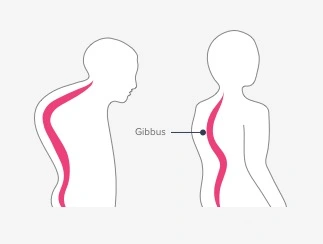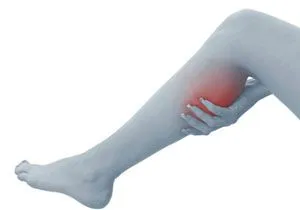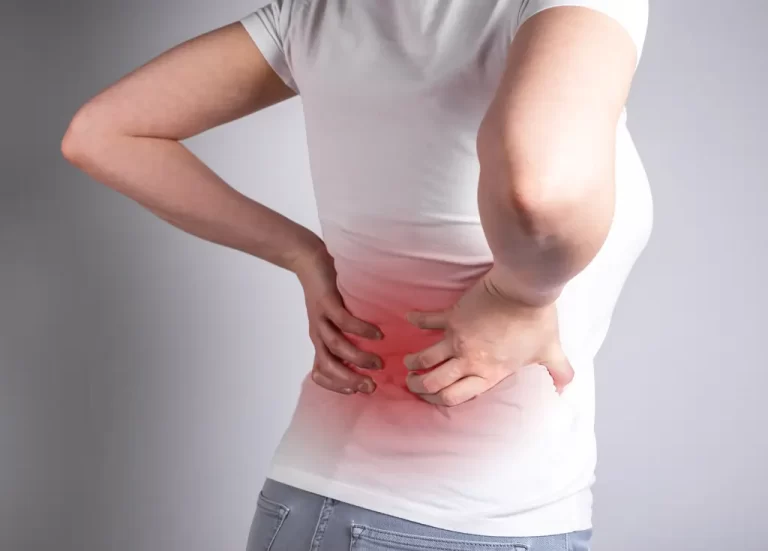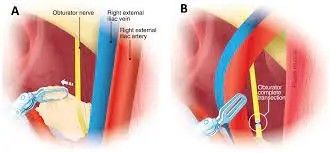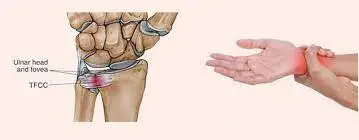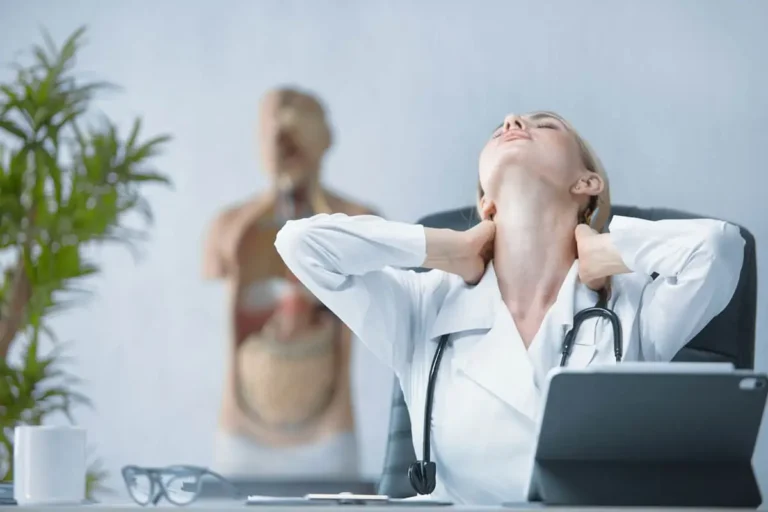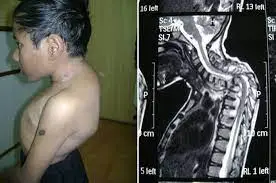Gibbus Deformity
What is a Gibbus Deformity?
Gibbus deformity is a spinal condition characterized by a sharp angulation or curvature of the spine, often resulting from a vertebral compression fracture.
This deformity can be caused by several conditions such as trauma, tumors, or congenital defects, but it is most usually linked to Pott’s disease, also known as TB of the spine.
The TB infection in Pott’s spine disease mostly affects the vertebral bodies, which results in bone loss. At that point, the spine bends suddenly forward as a result of the damaged vertebrae collapsing. The Gibbus deformity’s unusual hump-like appearance is caused by the angular deformity that results.
When a person is viewed from the side, they frequently exhibit a prominent protuberance or conspicuousness in the mid-back region as a result of this disorder. Other possible reasons include osteoporosis-related fractures, congenital spinal anomalies, spinal trauma or injury, and certain genetic disorders influencing bone growth.
The deformity results in an excessive forward curvature of the spine in the affected location when one or more vertebral bodies collapse or fuse together. As a result, the spine loses its proper alignment and the impacted vertebrae become compressed and distorted. Gibbus deformities can cause pain, limited mobility, and many cosmetic problems for those who have them.
A thorough physical examination, a clinical history questionnaire, and imaging modalities such as X-rays, computed tomography (CT) scans, or attractive reverberation imaging (X-ray) are typically used to determine gibbous distortion. The hidden cause, the severity of the deformity, and any associated adverse effects all influence the treatment decisions. Tormenting the executives, non-invasive treatment, and the use of orthotic devices to support the spine are examples of moderate management. Surgery may be required in more severe cases for deformity repair and spine stabilization.
Gibbus deformity patients need to work closely with orthopedic specialists and other medical professionals to determine the best course of therapy and handle any issues that may occur. Prompt mediation and appropriate management can help reduce suffering, enhance capacity, and improve the quality of life for persons affected by this condition.
Pathology
Gibbus deformity is essentially the result of tuberculosis’s damaging effects on the vertebral bodies.
The following is a breakdown of the pathogenic process that leads to gibbus deformity:
- Tuberculous Disease: Mycobacterium tuberculosis spreads hematogenously from the primary tuberculosis site elsewhere in the body to the spine in the early stages of tuberculous disease.
- Vertebral Body Inclusion: The anterior portion of the vertebral body is the main region impacted by the TB infection, leading to necrosis and bone loss. The intervertebral circles and adjacent endplates are completely destroyed as a result of the pollution.
- Granulation Tissue Formation: Incendiary cells, fibroblasts, and veins make up the granulation tissue that the body forms as a result of the illness. As a defensive mechanism, the granulation tissue tries to keep the infection under control.
- Vertebral extinction: occurs when the vertebral body is destroyed, weakening its main integrity and causing the affected vertebra to break down. This collapse results in the angular deformity known as the gibbous deformity.
- Stability of the Spine: As the vertebral bodies decompose, the affected spinal segment becomes less stable, which causes the deformity to gradually worsen. Neurological abnormalities could possibly arise from the collapse’s impact on the spinal cord or nerve roots.
- Formation of a Paravertebral Abscess: Paravertebral abscesses result from the TB infection permeating the surrounding soft tissues as well as the vertebral bodies. These abscesses may necessitate cautious waste and can further exacerbate the deformity.
If treatment is not received, the deformity known as Gibbs will eventually emerge due to the continuous collapse and destruction of several vertebral bodies. Severe pain, spinal instability, neurological deficiencies, cosmetic concerns, and neurological issues can all result from it.
It is imperative to obtain a precise diagnosis and promptly administer the necessary medical treatment, such as antituberculous medication, in order to prevent the deformity’s growth and minimize its implications. Surgery may be necessary in certain cases to rectify the deformity, decompress neural tissues, and stabilize the spine.
Types of Gibbus Deformity
It is often associated with congenital kyphosis or spinal TB (sometimes called Pott’s disease). Some instances of gibbous malformations are as follows:
- Gibbus Tuberculosis: The most common type of gibbus deformity is Gibbus TB, which is associated with Pott’s illness, sometimes referred to as spinal TB. It results from the destruction of the vertebral bodies caused by tuberculosis infection, which causes the spine to break down and become precisely deformed.
- Gibbus during birth: Formative abnormalities of the spine result in inborn gibbous deformity, which is present from birth. It could be related to diseases like scoliosis or congenital kyphosis.
- Gibbus Post-Traumatic: Serious spine traumas such as fractures or dislocations result in this type of gibbous deformity.
- Gibbus neuromuscular: Disorders affecting the muscles and nerves that regulate the spine may be the cause of gibbous deformity. Weakness or imbalance in the back muscles can result in progressive curvature and the development of a gibbous.
- Gibbus caused by injury: Iatrogenic gibbous deformities are Gibbus deformities that develop as a result of a medical operation or intervention. It may occur following spinal surgery, particularly in cases when there are issues with hardware malfunction, implant migration, or inadequate correction for the curvature of the spine.
These are a few of the more common types of gibbous deformity, but it’s important to remember that every patient will have unique traits and underlying medical issues. Gibbus distortion therapy and the board of Gibbus distortion may involve clinical administration, propping, or cautious intervention, depending on the underlying cause, the severity of the deformation, and specific patient variables.
Symptoms of Gibbus Deformity
Possible reasons include spinal tuberculosis (Pott’s disease), trauma, and congenital abnormalities. The symptoms may vary depending on the gibbus deformity’s degree and underlying cause. Among the common symptoms are:
- Back torment: The pain may be little or severe, and if you move or apply pressure to the region, it could get worse.
- Mobility limitations: The deformity may hinder spinal growth and result in reduced flexibility in the affected region. This restriction may make daily tasks difficult as well as make it more difficult to rotate, bend, or twist the spine.
- Breathing difficulties: In severe circumstances, gibbous malformation might impair the respiratory system’s normal function. The aberrant curvature may compress the lungs and chest cavity, which could lead to breathing difficulties, dyspnoea, and decreased lung capacity.
- Neurological side effects: Should the deformity apply pressure on the spinal cord or nerve roots, neurological problems could ensue. These may include weakness, shaking, or deadness in the arms, legs, or other body parts where the nerves are affected.
- Stiffness and fatigue: The limited range of motion and chronic pain associated with gibbus deformity can lead to fatigue and muscular weakening. This is particularly apparent in the back and core muscles.
It’s important to remember that these side effects can vary depending on the specific cause and personal circumstances. For a diagnosis and the best course of action, you should consult a doctor as soon as possible if you have any of these symptoms or suspect that you may have gibbous deformity.
Causes of Gibbus Deformity
Gibbus deformity, sometimes called kyphotic deformity, is an abnormal curvature of the spine characterized by a severe angulation or hump-like protrusion in the upper back. There could be a multitude of underlying problems and causes involved. Gibbus deformity frequently results from the following causes:
- M. tuberculosis: When a TB infection in the spine breaks down the vertebral bodies and the affected segments collapse, it might result in a gibbous deformity.
- Birth abnormalities: Gibbus deformation may progress as a result of these conditions.
- Osteoporosis: Severe osteoporosis can weaken the vertebral bodies. Gibbus deformity may arise from compression fractures, which are more prone to happen in the weaker vertebrae.
- Trauma: Severe spinal trauma, such as fractures or dislocations, can result in a vertebral collapse and a gibbous deformity. Trauma-induced abnormalities may also arise from compression fractures caused by high-impact injuries or accidents.
- Tumors: Both benign and malignant spinal tumors can compromise the structural integrity of the vertebral bodies. Gibbus deformation and spinal collapse can be triggered by the development of cancer.
- Ankylosing spondylitis: Ankylosing spondylitis is a persistent inflammatory disease that drastically affects the spine. Over time, the inflammation can lead to the development of kyphotic deformities, such as gibbous deformity, ankylosis, or the fusing of the spinal joints.
- Neuromuscular disorders: The neuromuscular ailments of muscular dystrophy and atrophy can cause the muscles supporting the spine to weaken and become unbalanced.
- Mechanical factors and poor posture: Prolonged poor posture, especially severe slouching or forward bending of the spine, can progressively change the spinal alignment and play a role in the development of gibbous deformity. Spinal or muscular imbalances are examples of mechanical variables that may possibly be involved.
It’s critical to keep in mind that the degree and underlying cause of gibbus deformity determine how the condition is treated and managed. Every situation requires a thorough medical assessment by a healthcare professional in order to decide on the best course of action.
Diagnosis
Gibbus deformity, sometimes referred to as kyphotic deformation or hunchback, refers to an atypical ebb and flow of the spine that causes the upper back to resemble a visible mound. There are two types of anomalies that might occur: congenital (existing from birth) and acquired (formed later in life). Gibbus deformity is usually diagnosed by a combination of imaging investigations, physical examination, and medical history. An overview of the demonstration cycle is provided below:
- Medical History: The physician should first obtain a complete medical history and ask about any symptoms, such as altered posture, restricted range of motion, or back pain. They will also ask about any relevant past surgeries, injuries, or medical issues.
- Examining the body: The physician will assess the patient’s posture for any signs of an unusually rounded upper back or a noticeable hump. In addition, they may check for neurological issues such as muscle weakness or loss of sensation.
- Imaging Research: To determine the severity of the gibbous deformity and to confirm the diagnosis, imaging investigations are usually required. Among the instances are:
- Radiography Spine X-rays can provide a thorough view of the spinal column, the degree of curvature, and any structural anomalies.
- Computed Tomography (CT) scan: A CT scan might be requested to get cross-sectional pictures of the spine. It makes it possible to examine the bones in greater detail and can be used to assess the degree of any skeletal anomalies or compression of the spinal cord or nerve.
- Magnetic Resonance Imaging, or MRI: It might help determine whether spinal tumors, infections, or spinal cord compression are the underlying causes of the gibbous deformity.
- Bone scintigraphy: When there is a suspicion of spinal TB, it might help to identify any active inflammation or infection in the spine.
- Extra testing: In certain cases, extra testing may be necessary to identify the underlying cause of the gibbous deformity. These could involve genetic testing, blood testing, or additional imaging investigations like ultrasounds or bone scans, depending on the suspected cause.
Once the diagnosis is established, a treatment strategy can be created based on the underlying cause and severity of the gibbous deformity. Options for treatment could include physical rehabilitation, physical support, brainwashing the executives, cautious intervention, or a combination of these approaches. It is crucial to speak with a licensed healthcare provider, such as an orthopedic surgeon or spine specialist, for an accurate diagnosis and personalized treatment suggestions.
Treatment of Gibbus Deformity
One feature of gibbous deformity, sometimes called angular kyphosis, is a malformation of the spine that resembles a hump. Although spine tuberculosis, or Pott’s disease, is the most common cause of it, congenital defects, trauma, and certain metabolic conditions can also cause it. Treatment for gibbus deformity depends on a number of factors, including the underlying cause, severity, and existence of concomitant symptoms.
Medical Treatment
When the deformity is moderate and does not produce apparent symptoms, conservative treatment could be adequate.
Mostly, this calls for a mix of the following:
- Brace work: Putting on an orthosis or spinal brace to stabilize the spine and stop the deformation from getting worse.
- Stretches and exercises: that strengthen the muscles supporting the spine, enhance flexibility, and improve posture are known as exercise therapy.
Surgical Treatment
Surgery might be necessary in cases of severe gibbus deformity or when non-invasive treatment is unable to relieve symptoms. The location and etiology of the deformity are among the parameters that define the specific surgical technique. Cautious decisions could consist of:
- Fusing the spine: One may use bone joins or embeds to progress the combination.
- Osteoplasty: A surgeon may occasionally perform a wedge osteotomy, in which a wedge-shaped section of the malformed vertebra is excised to treat the angular kyphosis.
- The instruments: Additional stability and support can be given by metal rods, screws, or other devices during the fusion process.
When choosing a treatment strategy, it is important to take into account the patient’s general health, the degree of the deformity, and the possible risks and benefits of each approach. An orthopedic surgeon or spine specialist must perform a comprehensive evaluation to determine the optimal course of treatment for gibbous deformity.
Physical Therapy Treatment
The term “gibbus deformity” describes an angular, kyphotic, aberrant curvature of the spine that is often linked to infections of the spine or illnesses such as “Pott’s disease.” Physical therapy can help control gibbus deformity by addressing pain reduction, encouraging overall functional well-being, improving posture, and increasing mobility.
It is important to remember that, depending on the underlying cause and severity of the deformity, therapeutic administration such as antitubercular medications or cautious intervention is typically part of the necessary therapy for gibbus deformation. Physical therapy can support these treatments and aid in rehabilitation.
Gibbus deformity can be treated with physical therapy in the ways listed below:
- Pain management: Physical therapists can employ various techniques to alleviate pain associated with gibbous deformity. Examples of these include hot/cold therapy, electrical modalities such as TENS and ultrasound, and manual therapy techniques including joint mobilization and soft tissue mobilization.
- Postural correction: Physical therapists can focus on enhancing postural alignment and muscular balance to reduce the deformity’s progression and associated pain. To strengthen weak muscles and lengthen taut muscles, they may prescribe specialized stretches and exercises. This could involve exercises that target the hip flexors, back extensors, and muscle strength, among other areas.
- Exercises to improve range of motion: Physical therapy may involve exercises designed to maintain or improve the range of motion in the spine and its supporting joints. Flexibility exercises, joint mobilization techniques, and mild stretching may be beneficial for the shoulders, hips, and spine.
- Stabilizing the core: Increasing the strength of the deep abdominal and back extensor muscles helps with posture and general spinal stability. Physical therapists may suggest certain exercises, such as planks, bridges, and abdominal bracing, to enhance core strength.
- Practical preparation: Physical therapists can assist individuals with gibbus deformity in performing activities of daily living and functional duties by teaching them appropriate body mechanics and movement methods. This can help minimize the impact of the deformity on daily activities and maximize functional independence.
It’s important to remember that the course of treatment may change depending on the state of the individual, the underlying cause of the gibbous deformity, and the severity of the distortion. A physical therapist will consider each patient’s unique requirements and develop a personalized treatment plan that takes into account their specific circumstances. For thorough management, collaboration with other medical specialists, such as professionals with training in physical therapy and medicine, may also be crucial.
Summary
Gibbus deformity refers to an unusual ebb and flow of the spine that is typically seen in the thoracic region of the upper back and is characterized by a crisp, precise conspicuousness. Although Pott’s illness, sometimes known as spine tuberculosis, is often linked to it, there are other potential causes.
FAQs:
Gibbus on the spine: what is it?
These abnormalities in the vertebrae are indicative of the collapse of one or more vertebral bodies, also known as a gibbous deformity, which produces kyphosis. This deformity is often caused by condition, metabolic problems, or congenital disorders.
How should a gibbus be examined?
The doctor could perform Adam’s test of forward bending: When you do that, your waist sags forward. The physician will be looking for either an angular curve or a rounded curve, which is more suggestive of postural kyphosis. The angular curvature, often called a gibbous deformity, becomes more noticeable when you lean forward.
What causes the creation of Gibbus?
Gibbus deformity is more common in children than in adults and is most commonly caused by tuberculosis osteomyelitis, however, it can also be caused by metabolic disorders or genetic abnormalities such as achondroplasia or cretinism.
Explain the Gibbus deformity.
The Latin word gibbous, which means “hump,” is the source of the adjective gibbous. It became part of Middle English to refer to rounded, convex items.
What differentiates gibbous and kyphosis?
Girdle kyphosis is a gibbous malformation. From behind, the curvature looks steeply slanted rather than smooth. Bending forward, a humpback with this deformity could be seen to be more pronounced. The curvature that is larger than typical is referred to as “extreme” (hyper) curvature.
What does TB gibbus formation mean?
Traditionally linked to tuberculosis, these abnormalities are mostly caused by spinal infections; other pathogens are hardly mentioned in the literature.
What shape is a gibbus?
The word “gibbous” comes from the Latin “gibbous,” which means “humpbacked.” When the moon is convex on both sides, giving it a “hump” shape, the phase between half and full is referred to as “Gibbus” (spelled gibbous) in English.
What physical results does Gibbus report?
The spinal canal anatomy is distorted, resulting in severe kyphosis, myelopathy, and even paraplegia.
Thoracolumbar Gibbus: What is it?
The collapse of one or more vertebral bodies, resulting in kyphosis, is known as gibbous deformity.
References
- Wikipedia contributors. (2022, April 8). Gibbus deformity – Wikipedia. https://en.wikipedia.org/wiki/Gibbus_deformity
- Patel, D. (2023, July 4). Gibbus Deformity – Cause, Symptoms, Treatment – Samarpan. Samarpan Physiotherapy Clinic. https://samarpanphysioclinic.com/gibbus-deformity/

